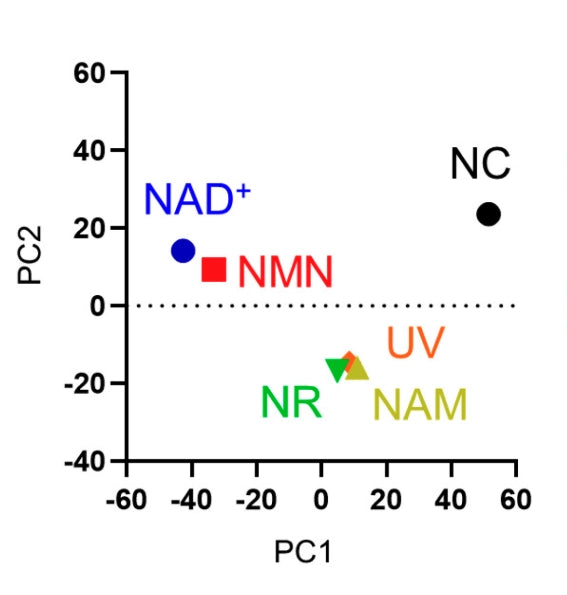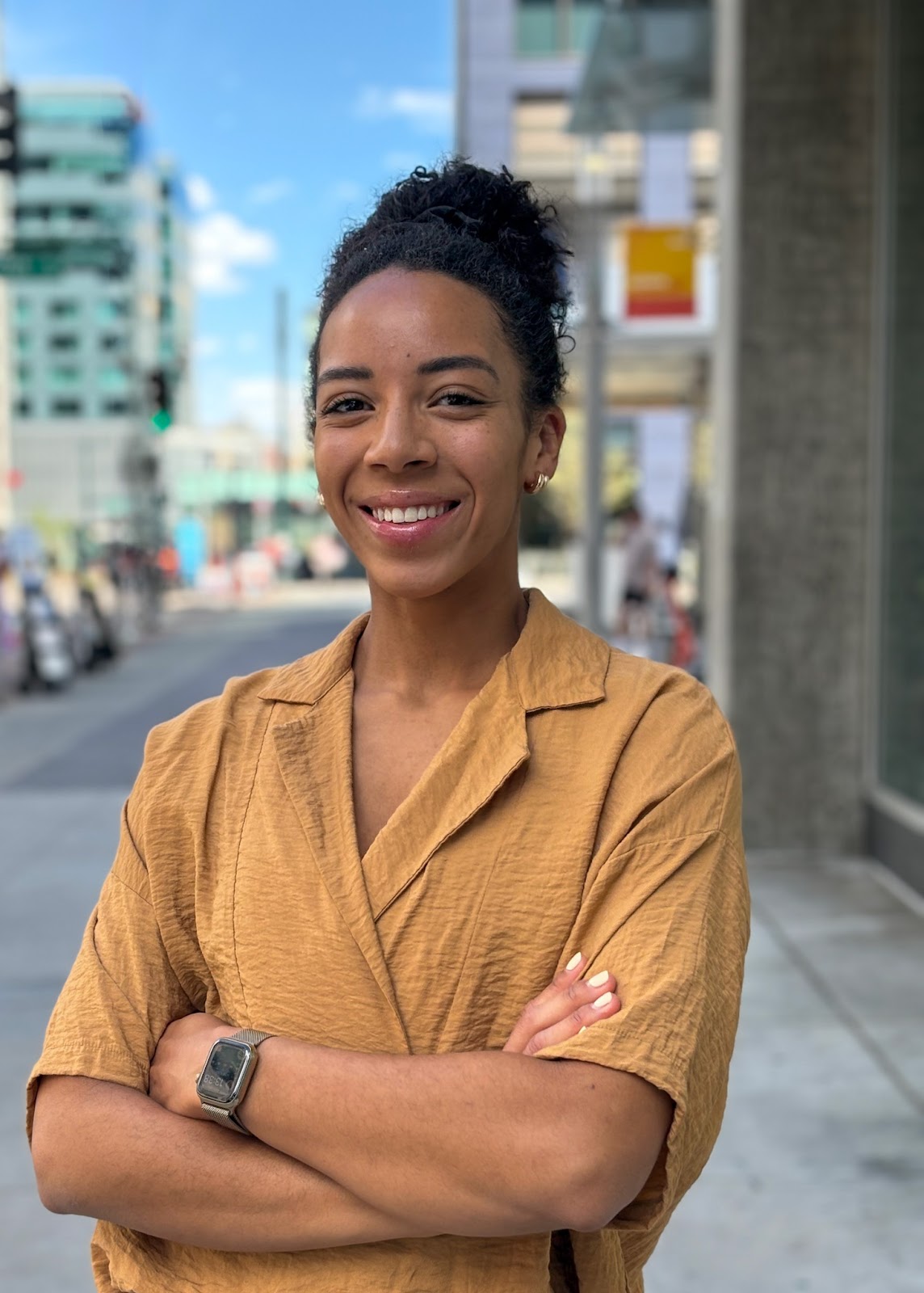
Key Points
- NMN outperformed NR and NAM, triggering stronger skin cell protection
- Cellular aging slowed through improved energy and repair activity
- Mitochondrial health and energy production were preserved
- Collagen production was restored after UV damage
- Senescent cells saw 30% reduction in senescent cells
What Researchers Did
Human skin fibroblasts, the cells responsible for producing the structural proteins that keep skin firm and elastic, were exposed to common aging stressors:
- Oxidative Stress: Mimicking damage from pollution and internal wear-and-tear using hydrogen peroxide (H2O2).
- Photo-Aging: Mimicking sun damage using UV light.
After stress exposure, each group of cells received one of four equal dose treatments:
- NAD+ (oxidized form)
- NMN (nicotinamide mononucleotide)
- NR (nicotinamide riboside)
- NAM (nicotinamide)
Researchers then measured NAD+ and ATP (energy markers) levels, gene expression (changes in DNA gene activity), mitochondrial health, collagen production, and wound healing ability.
NMN vs. Other Precursors: Distinct Gene Activations

This figure shows shows that NMN (red) and NAD⁺ (blue) treatments shifted skin cell gene expression profiles closer to the healthy control group (NC, black), while NR (green) and NAM (yellow) clustered with UV-damaged cells (orange). This indicates NMN and NAD⁺ reactivated repair and stress-resilience pathways that NR and NAM did not.
NMN reprogrammed cells toward repair, stress resistance, and survival pathways, while NR and NAM showed little effect. To understand why these NAD+ precursors produce different results despite raising NAD+ levels, it's important to recognize their distinct metabolic pathways and cellular uptake mechanisms.
"NAD+ and NMN triggered a significant biological response, while the other precursors did not."
Analysis showed that NMN uniquely activated genes that help cells remain strong and adaptive.
"Gene clusters unique to NMN involved cytokine signaling, protein homeostasis, and unfolded-protein response, suggesting improved stress adaptation and repair capacity."
"This result indicates that NMN may constitute a more favorable intervention strategy among NAD+ precursors."

Longevity Pathways Activated with NAD+ Restoration
NMN helped damaged skin cells recover nearly 80% of lost NAD+ levels.
"NMN dramatically restored the H₂O₂ [oxidative stress]-induced decrease in cellular NAD+ (78.8% compared to NC [control] without H₂O₂ treatment) and the NAD+/NADH ratio (82.6%)."
This increase turned on two powerful cellular anti-aging systems:
- Longevity Genes (Sirtuins): NMN boosted activity of SIRT5 and SIRT6, which help repair DNA and protect cells.
"Our findings indicate that NMN supplementation elevates intracellular NAD+ levels, which in turn activates sirtuins… NMN significantly elevated SIRT5 and 6"
- Cellular Recycling (Autophagy): NMN nearly doubled the cells' ability to recycle damaged components.
"NMN effectively activated autophagy by approximately 2-fold, which was similar to that by the positive control rapamycin…These results collectively demonstrate that NMN induces autophagy"
This suggests that by raising cellular NAD+ levels, NMN activated sirtuins and promoted autophagy, leading to enhanced mitochondrial function.
NMN Slows Cellular Aging and Protects Mitochondria
Importantly, NMN reduced senescence, the burden of cellular aging. Β-galactosidase, a key indicator of senescent cells, and expression of the senescence genes p16 and p21 decreased.
"In the β-galactosidase activity assay, NMN effectively decreased cellular H2O2-induced senescence (30.9% decrease). Gene expression analysis of P16 and P21 showed an anti-senescence effect of NMN"
Mitochondria, the energy centers skin cells need for all repair, collapse quickly under oxidative stress. NMN helped mitochondria maintain energy three times longer under stress.
"NMN was found to significantly increase the t1/2 [half-life] from 39.8 min to 120.3 min, implying that it slows down the progression of H2O2-induced aging."
By protecting mitochondrial function and reducing senescence, NMN helped preserve a pool of healthy, energy-producing cells that continue to divide and renew skin tissue.
Enhanced Collagen Production and Accelerated Wound Healing
UV exposure is one of the biggest causes of skin aging damaging collagen, the protein essential for skin structure and firmness. NMN treatment reversed UV damage and turned on key collagen producing genes.
"NMN effectively restored the UV-induced decrease in COL1A1 and COL3A1 expression."
Even after NMN treatment stopped, the cells maintained higher collagen levels, showing a lasting protective effect for more than 10 days. These findings align with previous research demonstrating NMN's ability to rejuvenate aging skin through improved mitochondrial function and reduced oxidative stress.
"The protective effect was maintained for over 10 days… highlighting the high potential of NMN as an effective agent for protecting against and delaying skin aging."

Cells were treated with NMN at 0, 1, 10, or 100 ppm (parts per million) for 24 hours after induced injury. Results showed a clear, dose-responsive enhancement of repair, with the strongest wound-healing effect observed at 10 ppm NMN.
NMN also helped skin cells repair themselves faster. Even at very low amounts, it increased cell movement and growth, to close the wounded area more quickly.
"Wound-healing effect of NMN… effectively increased cell migration and proliferation"

Conclusion
This data demonstrates that NMN provides superior advantages to NR and other NAD+ precursors for promoting long-term skin health.
"NAD+ and NMN induce robust and unique gene expression profiles, distinct from those elicited by NR and NAM…"
"…NMN suppressed cellular senescence, enhanced proliferation, supported extracellular matrix integrity, and promoted wound healing, thereby counteracting skin aging…"
"...NMN elevates cellular NAD+ levels, activates sirtuin and autophagy pathways, and improves mitochondrial function—all of which contribute to maintaining cellular homeostasis under oxidative and chronological stress."
Importantly, researchers concluded that NMN not only repaired age-related damage but slowed the aging process itself.
"By demonstrating that NMN not only mitigates existing damage but also actively decelerates the progression of aging, we highlighted its potential as a long-term skin longevity modulator."
"These findings were observed in human skin fibroblasts under controlled laboratory conditions (in vitro). Further studies in living tissue are needed to confirm clinical effects."



